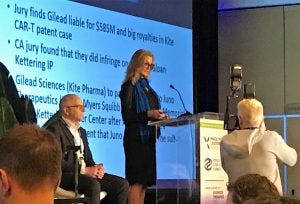
Top 10 advanced therapy milestones of 2019: Patient access takes center stageTop 10 advanced therapy milestones of 2019: Patient access takes center stage
CRISPR, capacity, and consolidation powered the cell and gene therapy space in 2019, but a proactive focus on patient access topped the annual roundup

CRISPR, capacity, and consolidation powered the cell and gene therapy space in 2019, but a proactive focus on patient access topped Falcon Therapeutics CEO Susan Nichols’ annual roundup.
In what has become one of the most anticipated presentations at the Phacilitate conference, Susan Nichols, CEO of cell therapy firm Falcon Therapeutics, laid out the top 10 events of the previous year that have shaped the regenerative medicine space, driving conversation, investment, and innovation.
The top spot in 2019 focused on efforts to increase patient access to the life-changing therapies entering the market, with May’s approval of Novartis/AveXis’ Zolgensma (onasemnogene abeparvovec) and its unprecedented $2.1 million (€1.9 million) price tag being the catalyst for change.

Image: iStock/Bedrin-Alexander
Nichols’ number one spot in 2018 centered around reimbursement conversations. Spark’s approval of gene therapy Luxturna (voretigene neparvovec) shook 2017, while Europe’s approval of ex-vivo stem cell gene therapy Strimvelis significantly advanced the sector in 2016.
For further context, check out the ‘Top 10 cell and gene therapy milestones of 2018’ here but here in reverse order is the full list of the top 10 key events of the previous 12 months, as presented at the conference in Miami, Florida:
10) Patent infringement upheld, Gilead liable
In December, a jury found Kite Pharma – owned by Gilead Sciences – guilty of infringing a patent exclusively licensed by Juno Therapeutics – owned by Bristol-Myers Squibb (BMS) – from researchers at Sloan Kettering and the Memorial Sloan Kettering Cancer Center.
The ‘190 patent relates to technology used in Kite/Gilead’s chimeric antigen receptor (CAR) T-cell therapy Yescarta (axicabtagene ciloleucel).
The jury’s decision left Gilead to pay $585 million plus 27.6% in royalties, totaling $752 million, to BMS and Sloan Kettering, resolving a case filed a day after Yescarta won approval in October 2017.
But in a post-script that could well feature on Nichols 2020 list, it has been suggested the emboldening of BMS has led the firm to file a motion last week to include punitive damages that would raise Gilead’s penalty to $1.5 billion.
9) First CRISPR gene therapy rare disease patients dosed in US
Vertex and CRISPR Therapeutics opened clinical trials in b-thalassemia and sickle cell disease to replace the defective genes that case these disorders and in November, the firms announced positive efficacy data from the first two patients treated with the investigational therapy CTX001.
Meanwhile, Editas Medicine and Allergan initiated clinical trials for their CRISPR-based candidate AGN-151587 (EDIT-101), aimed at treating Leber congenital amaurosis 10 (LCA10), an inherited form of blindness.
“The significance is CRISPR therapies have finally arrived in the clinic,” Nichols said.
8) Pharma and biotech inhouse manufacturing
With a lack of third-party capacity especially for viral vector production, 2019 saw numerous investments by major cell and gene therapy players to grow their internal networks. Some of the examples Nichols pointed out include:
Novartis, owner of Zolgensma manufacturer AveXis, acquired a facility in Longmont, Colorado from fellow Big Biopharma firm AstraZeneca to support gene therapy production. This came off the back of buying its CDMO CellforCure, adding a facility in Les Ulis, France.
Pfizer, meanwhile, ramped up its internal capacity in August with a $500 million investment in Sanford, North Carolina to construct a facility to support production of its recombinant adeno-associated virus (rAAV) vectors for use in its gene therapies and vaccines.
In March, bluebird bio cut the ribbon on a 125,000 square-foot facility in Durham, North Carolina
Precision BioSciences opened a cGMP manufacturing facility in North Carolina dedicated to genome-edited allogeneic CAR T-cell therapies
Gilead’s Kite continued to increase its footprint through a facility in Frederick County, Maryland expected to begin commercial production by late 2021
Regenxbio announced in May that it was constructing a facility at its headquarters in Rockville, Maryland, to support its NAV Technology-based vectors – used in its gene therapy candidates – at scales up to 2,000 liters
And Audentes Therapeutics laid plans to expand an AAV manufacturing plant in San Francisco, California to add an additional 8,000 liters of production capacity. Later in the year, Astellas cited the internal manufacturing capacity as a major driver in its $3 billion acquisition of Audentes
7) J&J data at ASH

Susan Nichols, CEO of Falcon Therapeutics, spoke last week at Phacilitate in Miami, Florida
Positive data from December’s American Association of Hematology (ASH) meeting in San Diego, California was a further boon for the sector, said Nichols.
J&J’s JNJ-4528, a CAR-T Cell Therapy Directed Against B-Cell Maturation Antigen (BCMA), reported a 100% remission rate and response from its Phase Ib/II CARTITUDE-1 trial. 69% of patients showed complete remission or better.
The candidate – licensed from Nanjing Legend in a $350 million deal – will move into a full Phase II study this year.
ASH also brought positive news from bluebird and BMS, which saw a 73.4% overall response rate in a Phase II KarMMa trial of its BCMA-targeted CAR-T candidate idecabtagene vicleucel.
6) Vertex acquires Semma
The $950 million deal, announced in September, adds Semma Therapeutics – a firm focusing on using stem-cell derived human islets as a possible cure for type 1 diabetes – to Vertex’ growing regenerative medicine portfolio.
For Vertex, the deal represented its entry into the cell therapy space, complementing its move into gene editing just months prior with the acquisition of Exonics and a research expansion with CRISPR Therapeutics.
But for the industry, the investment in a company developing a cell therapy for a large indication other than cancer is of major significance, said Nichols.
5) Astellas buys Audentes and Xyphos
As mentioned before, Astellas acquired Audentes for $3 billion, but the Japanese pharma firm also bought South San Francisco-based CAR technology developer Xyphos Biosciences as part of an end-of-year buying spree.
According to Nichols, these deals by Astellas are a “signifier that medium pharma may be using advanced therapies to grow and expand.”
4) CDMO M&A and consolidation
With a wealth of therapies moving through the clinic, capacity is at a premium and 2019 saw contract development and manufacturing organizations (CDMOs) scrabbling to secure capabilities.
Thermo Fisher acquired Brammer Bio for $1.7 billion, then Catalent paid $1.2 billion to add Paragon Bioservices to its CDMO offering. Both marked the first move into gene therapy services by the two large contract manufacturers. Nichols noted the size of the deals as being “somewhat impressive.”
In other signs of CDMO consolidation, Hitachi Chemical Advanced Therapeutics Solutions (HCATS) entered Europe by acquiring German cell therapy manufacturing firm apceth Biopharma, and Tennessee-based cell therapy firm Cognate acquired Swedish DNA and viral vector manufacturer Cobra Biologics.
3) Licensing deals
2019 also saw a flood of licensing deals with large upfront payments.
Roche is paying more than $1 billion upfront for the rights to Sarepta Therapeutics’ Duchenne muscular dystrophy (DMD) gene therapy outside of the US.
Genentech entered a $300 million with Adaptive Bio for access to its T-receptor discovery and immune profiling platform, though the deal could be worth up to $2 billion.
And Vertex, as previously mentioned, inked a $175 million deal with CRISPR Therapeutics for its gene therapy pipeline.
2) More fuel to the fire for Big Pharma
We saw medium pharma grow. We saw major licensing deals. We saw CDMO consolidation. But we also saw Big Pharma’s buying power make a significant impact on the cell and gene therapy space in 2019.
The biggest deal saw BMS buy Celgene for a whopping $74 billion, bringing with it several CAR-T programs.
But Roche’s $4.8 billion acquisition of Spark Therapeutics – which has already seen commercial success with Luxturna – was also significant, as was Biogen’s $877 million purchase of Nightstar Therapeutics, Pfizer’s stake-in and option to buy out Vivet, and Bayer’s acquisition of the remaining shares of BlueRock Therapeutics.
“These signal that Big Pharma is optimistic to M&A in the advance therapy space and the value that these therapies can bring,” said Nichols.
1) Patient access
The business model for this new breed of curative medicines is significantly different to that of traditional pharma and biologics, and patient access poses a challenge. With the arrival of Zolgensma and its $2.1 million price tag, the conversations have changed, and all elements of the industry have been forced to address how to manage patient access.
Zolgensma represents a life or death drug for 68% of pediatric patients with SMA1. The patients must be dosed before the age of two, yet only around ten states offer screening before this age.
“We need to work as an industry to ensure reimbursement and access is in sync with approvals,” said Nichols. However, she added, “we must move the conversation to state level” and bring state Medicaid and insurance companies to the core of the conversation.
The year saw positive signs that change is happening.
Nichols noted that “patient advocacy voices are loud” across all disease indications pushing for access to these next-generation medicines. Meanwhile Novartis’ suggested lottery-style free drug program – despite some criticism – demonstrates industry itself is looking for innovative ways to improve access.
About the Author
You May Also Like
schedl_b_and_w.jpg?width=100&auto=webp&quality=80&disable=upscale)
schedl_b_and_w.jpg?width=400&auto=webp&quality=80&disable=upscale)



